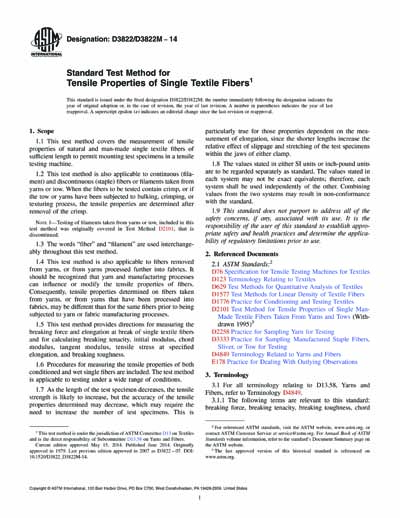Historical
ASTM D3822/D3822M-14
Standard Test Method for Tensile Properties of Single Textile Fibers
1.1 This test method covers the measurement of tensile properties of natural and man-made single textile fibers of sufficient length to permit mounting test specimens in a tensile testing machine.
1.2 This test method is also applicable to continuous (filament) and discontinuous (staple) fibers or filaments taken from yarns or tow. When the fibers to be tested contain crimp, or if the tow or yarns have been subjected to bulking, crimping, or texturing process, the tensile properties are determined after removal of the crimp.
1.3 The words “fiber” and “filament” are used interchangeably throughout this test method.
1.4 This test method is also applicable to fibers removed from yarns, or from yarns processed further into fabrics. It should be recognized that yarn and manufacturing processes can influence or modify the tensile properties of fibers. Consequently, tensile properties determined on fibers taken from yarns, or from yarns that have been processed into fabrics, may be different than for the same fibers prior to being subjected to yarn or fabric manufacturing processes.
1.5 This test method provides directions for measuring the breaking force and elongation at break of single textile fibers and for calculating breaking tenacity, initial modulus, chord modulus, tangent modulus, tensile stress at specified elongation, and breaking toughness.
1.6 Procedures for measuring the tensile properties of both conditioned and wet single fibers are included. The test method is applicable to testing under a wide range of conditions.
1.7 As the length of the test specimen decreases, the tensile strength is likely to increase, but the accuracy of the tensile properties determined may decrease, which may require the need to increase the number of test specimens. This is particularly true for those properties dependent on the measurement of elongation, since the shorter lengths increase the relative effect of slippage and stretching of the test specimens within the jaws of either clamp.
ASTM International [astm]

